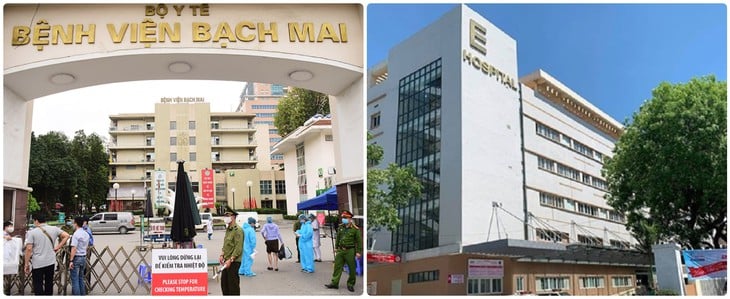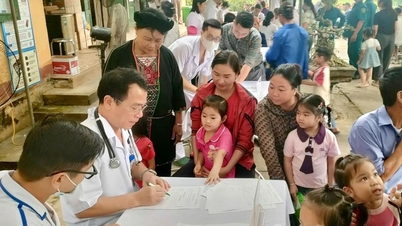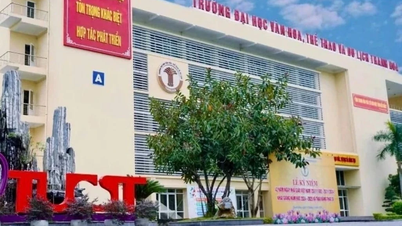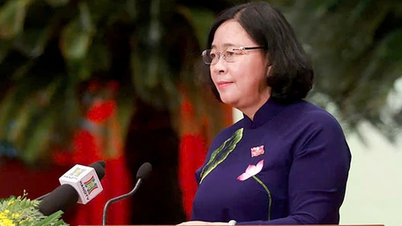
The Ministry of Health has just proposed a plan to merge Hospital E into Bach Mai Hospital - Photo: BVCC
This proposal is part of the roadmap to streamline and reorganize public health service units according to the direction of the Central Steering Committee on summarizing Resolution 18, while aiming to build a chain of leading hospitals and maximize available resources.
Merging two major hospitals?
E Hospital was established in 1976, currently has a scale of more than 1,000 beds, 62 departments, functional rooms and a Cardiovascular Center. With a campus of more than 41,000 m², the hospital is highly appreciated for its green - clean - beautiful medical examination and treatment environment.
Over the years, E Hospital has successfully implemented a series of specialized techniques such as open heart surgery, percutaneous cardiovascular intervention, craniocervical and spinal surgery, gastrointestinal endoscopy, laser lithotripsy, artificial blood filtration, etc. and is the practice facility of many medical schools. This is also the leading medical facility in cardiovascular surgery and intervention.
Bach Mai Hospital is the first special-grade general hospital in Vietnam, playing the highest role in the medical examination and treatment system. With 56 specialized units, 3,200 beds and more than 4,000 medical staff, this is the place to receive and treat many complicated cases from all over the country.
In addition, Bach Mai's second facility project with 1,000 inpatient beds, serving about 5,000 medical examinations per day, aiming at a modern general hospital model in Ninh Binh is also being urgently completed and put into operation this year.
These are two large-scale hospitals, under the Ministry of Health. According to experts, the merger could create a large-scale, highly specialized hospital system, contributing to the formation of a "leading hospital chain" as the Ministry of Health's goal.
However, the merger process also raises many concerns, such as the differences in organizational structure, operating culture, management model and development orientation between the two hospitals.
In particular, for the patient, if the reorganization process is not reasonable, the medical examination and treatment process may be disrupted, directly affecting the patient's rights.
Therefore, when the proposal to merge E Hospital into Bach Mai Hospital was proposed by the Ministry of Health, it caused a stir in the medical community.
Don't just reduce "mechanics"
The Ministry of Health currently directly manages 90 units (including 4 hospitals that will be handed over in 2025), of which: the agency serving state management has 3 institutes; the medical examination and treatment sector has 35 hospitals; the reserve sector: 11 units; the training sector: 12 units (including 1 college), etc.
The Ministry of Health proposed a plan for reorganization, in which 13 units are expected to be transferred to localities and 11 units will be reorganized.
According to Dr. Quan The Dan, professional director of Tri Duc Thanh General Hospital - Thanh Hoa, to deal with the large number of centrally-affiliated units, the Ministry of Health is planning to transfer some units to the locality, and merge others. In particular, it is planned to merge E into Bach Mai and retain some large facilities.
He commented that this merger would mechanically reduce the number of centrally-affiliated units in the short term, but in the long term it would not necessarily make the units operate better, and would even make it more difficult, reducing patients' access if the governing mechanism did not change.
"Bringing central hospitals to local areas may lead to some differences in professional qualifications between hospitals, leading to inadequacies in management. The transferred units themselves will also lose their invisible advantages - "upper level, central level". And the facilities subject to merger may lose their inherent dynamism," Dr. Dan commented.
An expert in the medical field also said that the merger of Bach Mai Hospital and E Hospital sounds like a reform, but in reality it is like... "pouring more water into a glass of wine that is already bland."
According to this person, the two hospitals are far apart, each with its own characteristics, but the management mechanism has not changed, the budget must be requested, equipment must wait for approval, and personnel cannot make their own decisions.
"Combining them without reform is no different than adding layers of procedures, making operations more complicated," he commented.
Some other experts are concerned that the two large hospitals coming together, plus the Bach Mai Hospital 2, which is about to be put into operation, will become a "super hospital" model. And then, operations will be even more difficult, from human resource management, bidding, purchasing, etc., the increased workload will become a big challenge.
Need to arrange, suitable route
Doctor Dan also proposed that the rearrangement of units under the Ministry of Health is an opportunity to develop a pilot roadmap to gradually eliminate the mechanism of the parent ministry with central health units. Only subsidizing research institutes on epidemiology, infectious diseases, and occupational diseases should be provided, because of their community service nature.
Let the remaining units operate according to the law: the law on medical examination and treatment, the law on education, the law on pharmacy... Thus, the Ministry of Health will be relieved of the burden of "management" to focus on indirect management in the direction of policy creation and inspection.
Social security policies are implemented through direct support to the health insurance fund, major national health programs are implemented through competitive bidding between hospitals. Hospitals, universities, research institutes, pharmaceutical enterprises... will proactively develop, choose their own path, and decide for themselves whether or not to associate or merge.
"The ratio of doctors per capita in Vietnam is still low, the number of hospitals is still small, there is still a lot of room for the medical industry to develop, as long as there are appropriate liberalization policies. Eliminating or at least limiting the management policy, so that units can be completely autonomous will create a boost for further development of the medical industry," Dr. Dan expressed.
Source: https://tuoitre.vn/benh-vien-e-va-benh-vien-bach-mai-nhieu-ban-khoan-neu-hai-benh-vien-lon-ve-chung-nha-20251015174728755.htm



![[Photo] Conference of the Government Party Committee Standing Committee and the National Assembly Party Committee Standing Committee on the 10th Session, 15th National Assembly](https://vphoto.vietnam.vn/thumb/1200x675/vietnam/resource/IMAGE/2025/10/15/1760543205375_dsc-7128-jpg.webp)
![[Photo] Many dykes in Bac Ninh were eroded after the circulation of storm No. 11](https://vphoto.vietnam.vn/thumb/1200x675/vietnam/resource/IMAGE/2025/10/15/1760537802647_1-7384-jpg.webp)
![[Photo] The 18th Hanoi Party Congress held a preparatory session.](https://vphoto.vietnam.vn/thumb/1200x675/vietnam/resource/IMAGE/2025/10/15/1760521600666_ndo_br_img-0801-jpg.webp)







































































































Comment (0)